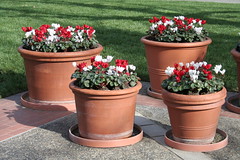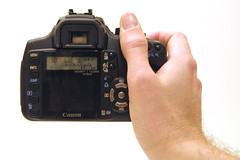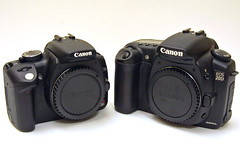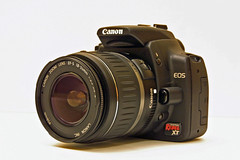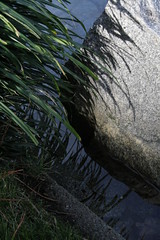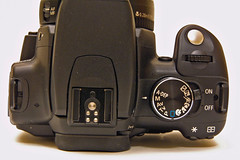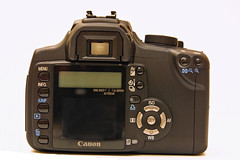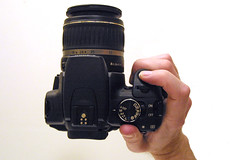Canon 350D GuidePosted on December 27, 2005 I'd like to begin this Canon 350D guide with a disclaimer: I have been a long-time fan of Canon cameras. Since I started this web site I have had the opportunity to use several non-Canon models, and I have been impressed with the results. But Canon cameras are what I am most familiar with, and I was excited to try out the successor to one of the most popular digital SLR cameras: the Canon EOS 300D Digital Rebel. Before I get too far along, let's talk about names. The Canon 350D is also called the Digital Rebel XT and the Kiss N Digital. For the purpose of this review, I will refer to it as the 350D. With the naming issue out of the way, let's get started with the Canon 350D guide! |
 |
Who This SLR is For
The Canon EOS 350D is for anyone who wants a small portable camera that can produce crystal-clear 12x18 prints.
The camera is fast enough for the casual action photographer, but it doesn't measure up to the Canon 20D or Nikon D2X in terms of speed.
Since it produces very low noise at all ISO settings, this is a great camera for photographers who don't like to use a flash.
Key Features
- 8.0 megapixel sensor
- Compatible with all Canon EOS lenses
- 2.8 photos per second
- 7-area autofocus system
- ISO setting from 100 to 1600
- Maximum shutter speed of 1/4000 of a second
- 1.6 times crop factor
- 1.8" LCD
- Stores photos on Compact Flash
Oddities
The most significant issue I had with the Canon EOS 350D is its size, which is ironic since this is also a selling point for the camera.
The EOS 350D is exceptionally compact, and Canon has eliminated some of the controls available on their other digital SLRs.
I found that this not only makes the camera hard to operate, but also a little difficult to hold.
I have small hands but long fingers, and found that I got a bit of a cramp after shooting with the 350D for an extended period of time.
Since the grip is so small, I was unable to get a good handle on the camera, and had to hold it tight for fear of dumping it on the ground.
My wife, on the other hand, had no problem at all and really enjoyed the fact that the camera is so small and light.
She is used to using the Canon 20D digital SLR, and the 350D is quite tiny in comparison.
Here's the best advice that I can give to you if you're considering buying the Canon Rebel XT: hold one first.
Go to any local camera store with floor models, pick the camera up and hold it in your hand for awhile.
Many of you will find that the camera fits just fine and will be rewarded by having a digital SLR that doesn't weigh a ton and require a duffel bag to carry around.
Others will find that the camera is simply too small to get a good grip, in which case a larger camera will suit you better.
The Hidden Cost
When people ask me why they shouldn't get a camera with a huge number of megapixels, I tell them about the hidden costs of owning a camera like this.
There are actually three of them:
- You need larger memory cards
- You need a larger computer hard drive
- You need a more powerful computer
First, you won't get the same mileage out of your 256 Megabyte memory card with an 8 megapixel camera as you with with a 6 megapixel camera.
You will only be able to store about 72 photos instead of 81.
Granted, this first issue won't break your bank. A 512 Megabyte card (that stores about 145 photos), only costs about $25 more than a 256.
The second issue is a problem for photographers who take a lot of shots (like me).
Each 8 Megapixel file eats up about 2.5 Megabytes of drive space on you computer's hard drive. If you take 1,000 photos you'll use 2,500 Megabytes or about 2.5 Gigabytes of room.
It's much easier than you think to quickly fill up a 20GB hard drive with 8 megapixel photos, especially if you are competing with a son or daughter who is filling up the hard drive with music downloads.
The last issue is probably the most limiting: you really do need a powerful computer if you want to look at and edit your 8 megapixel photos.
A computer with a slow processor, small hard drive and 256MB of RAM (random access memory) isn't going to cut it.
Here's an easier way to think about it: if your computer is 3 or more years old, you're probably going to need a new one to handle the photos you take.
How This SLR is Different
First, the Canon EOS 350D is one of the most popular cameras in the entry-level digital SLR market.
The camera that came before it, the 300D Digital Rebel, generated a lot of buzz at the time since it was the first digital SLR that you could buy for less than $1,000.
So how do you follow up a camera like that?
More Megapixels
Remember, you only need more megapixels when you want to print photos at large sizes.
The Canon EOS 350D and the Olympus E-500 are the only two 8 megapixel digital SLRs under $1,000.
This means that the photos you take with the EOS 350D will print beautifully up to 12x18 inches (and even larger than that if you're not exceptionally picky about image quality).
Want to create stunning poster-size prints to hang in your home? This is the camera for you.
Small Size
I've already talked a lot about the small size and light weight of the Canon EOS 350D, so here's the comparison table that will help prove the point.
| MAKER | CAMERA | DIMENSIONS (inches) | DIMENSIONS (mm) |
| Canon | EOS 350D | 5 x 3.7 x 2.5 | 127 x 94 x 64 |
| Pentax | *ist DL | 4.9 x 3.7 x 2.6 | 125 x 93 x 66 |
| Olympus | E-500 | 5.1 x 3.7 x 2.6 | 130 x 95 x 66 |
| Nikon | D50 | 5.2 x 4 x 3 | 133 x 102 x 76 |
The Rebel XT is in close competition with the Pentax *ist line of digital cameras (the D, DS, DS2 and DL) for the title of smallest-sized digital SLR camera.
Along with this small size, the EOS 350D doesn't weight a lot. It's not as light as the Olympus E-500, but it's on the low end of the weight scale.
While I try to avoid tables as much as possible, here's another so you can compare the weight.
| MAKER | CAMERA | WEIGHT (oz) | WEIGHT (g) |
| Olympus | E-500 | 16.9 | 479 |
| Canon | EOS 350D | 19 | 540 |
| Pentax | *ist DL | 19.9 | 565 |
| Nikon | D50 | 21.9 | 620 |
This makes the EOS 350D the ideal camera for travel photographers who enjoy large prints.
High Image Quality, Low Noise
I spent a lot of time during my Canon EOS 350D guide playing with the camera's ISO setting.
I took an entire set of photos at ISO 1600 to see how the images would turn out. I'll direct your attention to the photo samples at the bottom of this page and let you decide, but I was impressed.
Even at a high ISO setting like 1600, grain and image noise is minimal, and you have to really know where to look to find it.
This is great news for available-light photographers, who don't want to always have to use the camera's flash. At ISO 1600 you can take clear photos holding the camera in your hands, even if you're indoors on an overcast day.
When you pair this with the 8 Megapixel senor, it provides you with a lot of flexibility when taking photos in any light conditions.
Look and Feel
The Canon EOS 350D is really small.did I mention that already?
The most obvious omission on the 350D is a status panel on the top of the camera next to the shutter button.
Every other digital SLR, including the Nikon D50, Minolta Maxxum 5D and the Pentax *ist DL has a small screen on the top of the camera that displays camera settings like shutter, aperture, battery life, ISO and white balance.
To save space, Canon moved this panel from the top of the camera to the back above the LCD.
There are two consequences of this change: first, anyone used to using a film SLR with the readout on the top is going to have to re-learn where to look when using manual controls on the 350D.
The second issue of moving this display is that it limits the size of the LCD.
While the Nikon D50 has a bright 2 inch LCD, and the Minolta Maxxum 5D has a 2.5 inch LCD, the LCD on the Canon EOS 350D is only 1.8 inches.
This may not seem like a huge difference, but when you are trying to review your photos, every extra fraction of an inch counts.
How It Works
Canon packed a lot of controls in a very small amount of space.
While all the buttons that you need are right at your fingertips, using the camera in manual mode leaves a lot to be desired.
It's pretty much impossible to change settings while looking through the viewfinder, due to the finger gymnastics required for most operations.
This will be no problem at all for anyone who just wants to use program modes, but film photographers used to manual controls are going to have a tough time changing aperture and shutter speed at the same time.
Autofocus
The Canon EOS 350D autofocus is responsive and accurate, even in low-light conditions.
I spent a lot of time photographing my son indoors at night and the 350D had no problem at all focusing where and when I wanted it to.
Pop-up Flash
Speaking of photos at night, the 350D has a built-in flash unit that virtually eliminates red-eye.
It eliminates red-eye because it pops up far away from the camera body. Red-eye is caused when the flash is too close to the lens, and with the 350D, the flash is nowhere near the lens.
If you find yourself taking a lot of indoor shots where flash is required, you won't have to spend a lot of time after the fact editing out the red-eye from your digital photos.
The Kit Lens
The most common Canon kit comes with an 18-55mm f/3.5-5.6 lens.
I would call this about a B+ lens, considering the fact that there are over 50 other Canon lenses that you can choose from.
It's a good lens if you are getting started in photography, and just want to get the camera and lens all at once so you can start snapping away.
It works well for portraits and landscapes, since it has a nice wide angle setting (at 18mm) and is optimized to work with the 350D's smaller sensor.
If you really have a dream to take better photos (which is why you're getting a digital SLR in the first place) then you should consider only getting the camera body and finding a better Canon lens to go with it.
The Pros and Cons
| Pros | Cons |
|
|
Price Analysis
This table shows how the Rebel XT compares other digital SLR cameras with similar features.
| MAKER | CAMERA | PRICE |
| Pentax | *ist DL with 18-55mm Lens | $ 533.00 |
| Nikon | D50 with 18-55mm lens | $ 627.00 |
| Olympus | E-500 with 14-45mm lens | $ 700.00 |
| Canon | EOS 350D with 18-55mm lens | $ 780.00 |
Canon Rebel XT Kit
The most common Digital Rebel XT kit comes with a Canon EF-S 18-55mm f/3.5-5.6 lens. This lens works well for landscape photography, but isn't optimal for low-light conditions.
350D Rebel XT Body
If you just want the 350D body without a lens, it's going to run you about $800.
Canon 350D Photo Samples
 |
 |
 |
 |
 |
 |
 |
For Owners
User Manuals
- Canon 350D User Manual (U.S.)
- Canon User Manual (UK) - in the UK, user manuals must be purchased individually and are not available online
Reference Guides
| United States | United Kingdom | ||
Learn how to use all of the features of your Canon EOS Rebel XT and dramatically improve the photos you take with five online digital SLR lessons
| Digital SLR Home | Other Camera Guides |
